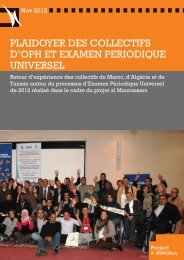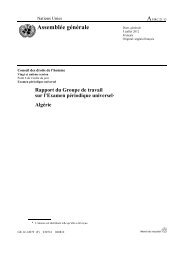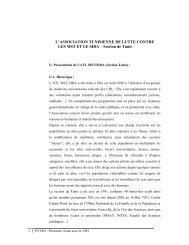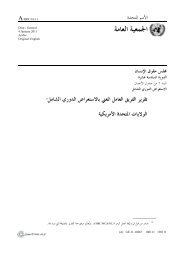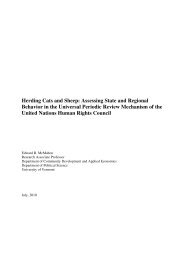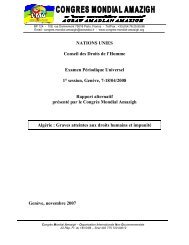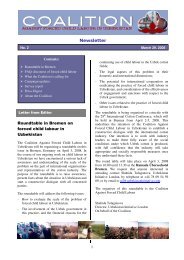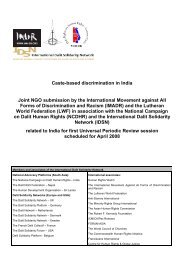3. Framework3.1. Poverty in the PhilippinesIn the National Economic Development Authority (NEDA) report “Second PhilippinesProgress Report on the Millennium Development Goals” it is stated that as of 2003,30.4% of the Philippine population lives below the poverty line. That is about 25 millionindividuals out of a population of 85 million.The Food and Nutrition Research Institute (FNRI) reported that in 2003, for every 100pre-school children, 32 were anemic, 30 were under-height and 28 were underweight.For every 100 school-age children, 37 were anemic, 36 were under-height and 27 wereunderweight. Overall, around 5 million pre-school and school-age children areunderweight and 7 million under-height and anemic (Florencio, Cecilia, “Nutrition in thePhilippines”, p. 140, 2004, University of the Philippines Press). The malnutrition problemof the Philippines has caught the attention of the UNICEF (United Nations Children’sFund). Dr. Nicholas Alipui, the Country Representative, observed that child malnutritionhas remained high at 30% in the last 10 years. He warned that malnutrition leads to“lower intelligence, reduced physical capacity and passing it on to the nextgeneration….” Dr. Alipui added that children have a right to be free from malnutrition.(“UNICEF raise alarm on malnutrition in RP”, INQ7.net, 4-7-06, by Veronica Uy)According to one survey, about 700,000 families experience severe hunger, or about 3.5million persons. Most of the hungry people are in Mindanao (21%), followed by theNational Capital Region (NCR) (18.3%), the Visayas (16%) and Luzon (14.7%).(“Hunger hits new record high of 16.9%”, May 5, 2006, Social Weather Stations).Significantly, according to the Asian Development Bank almost three-fourths of thecountry’s poor are rural poor (ADB, 2005).3.2. Agrarian Reform as a Human Rights Issue3.2.1. Economic, Social and Cultural Rights, esp. the Right to Adequate FoodThe human right to food is enshrined in article 25 of the UN <strong>Universal</strong> Declaration ofHuman Rights and article 11 of the International Covenant on Economic, Social andCultural Rights (ICESCR) of the United Nations. In 2004, 187 states agreed for the firsttime in history, on a document identifying the content of one of rights covered byICESCR, namely the right to adequate food. During the UN Food and AgricultureOrganisation (FAO) Council in November 2004, “The Voluntary Guidelines to Supportthe Progressive Realisation of the Right to Adequate Food in the Context of NationalFood Security” (henceforth referred to as VG) was unanimously adopted, providingstates with guidelines on how to progressively realize the right to adequate food asstated in the ICESCR. The VG addresses the issue of access to land and the need foragrarian reforms. In paragraph 1 of the VG, following the authoritative interpretation ofIFFM 2006 Final Report 12
the right to food in General Comment No. 12 (GC 12), by the Committee on Economic,Social and Cultural Rights, makes reference to the basic content of the right to food andstates: “These Voluntary Guidelines aim to guarantee the availability of food in quantityand quality sufficient to satisfy the dietary needs of individuals; physical and economicaccessibility for everyone, including vulnerable groups, to adequate food, free fromunsafe substances and acceptable within a given culture; or the means of itsprocurement.”The VG and GC12 make it clear that the direct availability of food through an individualor collective cultivating her own land is part of the basic content of the right to adequatefood for individuals and rural groups who want to exercise this right as such (Monsalve2006). The direct availability of food through one’s own cultivation implies economicaccess to productive resources: it is necessary to have access to land and access toother productive resources in order to be able to cultivate the land and to have directavailability of food. This implies then that access to land is part of the basic content ofthe right to adequate food, be that land in order to cultivate it and feed oneself, or to takeadvantage of other natural sources of food. The Special Rapporteur on the Right toFood, Jean Ziegler, also affirms that “access to land and agrarian reform must form akey part of the right to food” given that “access to land is often fundamental for ensuringaccess to food and to a livelihood, and therefore freedom hunger”Due to the close correlation between access to land and the right to food, three types ofobligations can be directly applied to access to land: State Parties to the ICESCR areobligated to respect, protect and fulfil access to land, given that this forms part of thebasic content of the right to food and is particularly important for peasants, indigenouspeoples, fisherfolks, pastoralists, and people living in rural areas and who have noalternative options for earning a living. The Special Rapporteur on the Right to Food hasalready adopted this interpretation and considers it to be clear that governments shouldrespect, protect and fulfil access to land.The 2006 International Conference on Agrarian Reform and Rural Development(ICARRD), hosted by the UN Food and Agricultural Organisation (FAO) and theBrazilian Government, also highlights the importance of agrarian reform for therealisation of basic human rights. In its final declaration, the conference stressed theeminent role of agrarian reforms to combat hunger, the need for a model of sustainabledevelopment and the implementation of human rights. It states that agrarian reformsshould promote economic, social and cultural rights, especially for women, marginalisedand vulnerable groups. Especially in areas with strong social disparities, poverty andhunger, agrarian reform should broaden and secure access to, and control over, landand other resources. States have a crucial role in the implementation of agrarian reform.3.2.2. Civil and Political RightsParagraph 19 of the VG emphasizes that obtaining food security is based on therealisation of existing rights, that applying the principles of human rights are an integralpart of the process and that citizens have rights and are not mere passive recipients. Inthis sense, respecting and protecting the civil and political rights contained in theIFFM 2006 Final Report 13




